
A painful, vesicular eruption; an asymptomatic red macule; a rapidlyspreading erythematous plaque--can you identify the disorderspictured here?

A painful, vesicular eruption; an asymptomatic red macule; a rapidlyspreading erythematous plaque--can you identify the disorderspictured here?

Asymptomatic purpura, slightly pruritic papules, a scaly eruption in thegroin--can you identify the disorders pictured here?

Test your knowledge of dermatology with 4 cases, 4 photos, 4 different rashes . . . which are the result of a drug reaction?

A spreading pruritic rash, an eruption of vesicles, an intermittently pruritic lesion--can you identify the disorders pictured here?

A 34-year-old woman awoke with apainful, crusted ulcer on her upperarm. She has been repairing dry wallin her home but recalls no trauma.The necrotic ulcer features an erythematousborder.

Dermclinic: A Photo Quiz to Hone Dermatologic Skills

A pruritic facial eruption; asymptomatic, erythematous lesions;a persistent papule--can you identify the disorders pictured here?

For 2 months, a 19-year-old woman has had a slightly tender acneiform eruption on the trunk that spread to the extremities.

An asymptomatic acneiform eruption; persistent, mildly pruritic papules; a pustular rash that resists antibiotics--can you identify the disorders pictured here?

An erythematous eruption on the eyelids, asymptomatic papules on the extremities, an acneiform rash--can you identify the disorders pictured here?

An acneiform eruption, pruritic papules on the extremities, pustular scalp lesions--can you identify the disorders pictured here?

A verrucous birthmark, a rash at the commissure of the lips, proximalnail changes--can you identify the disorders pictured here?

A 70-year-old woman was bothered by a pruritic, reddened site on her left shoulder. The lesion progressed with a linear, erythematous eruption leading to her axilla and caused tender adenopathy.
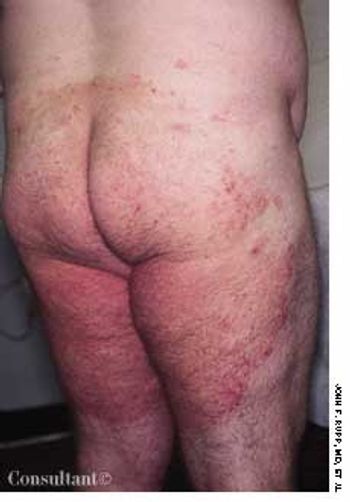
Dermatophyte infections have a predilection for certain anatomic sites, such as the feet, groin, and scalp. Tinea corporis refers to involvement of the trunk and extremities. The condition arises either from direct exposure to an infected source or by extension from an adjacent affected site. Itch is a common symptom, but the intensity of the pruritus can vary from patient to patient.
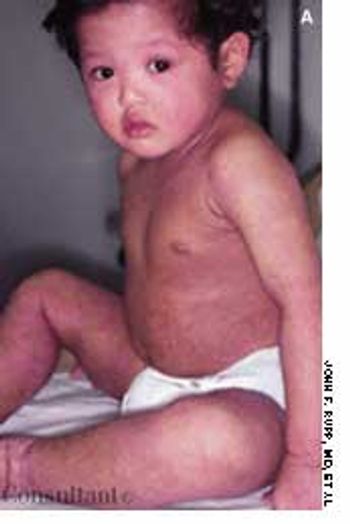
The onset of atopic dermatitis can be seen in infants who have a family history of inhalant allergies, (eg, seasonal allergy, allergic rhinitis, or allergy-induced asthma). The cheeks and large flexural folds of affected children are erythematous and scaly. Involved areas of the trunk and extremities may exhibit discrete patches or a generalized rash.
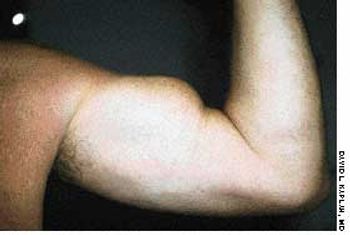
The unusual muscle definition in this 57-year-old man was noted during a routine physical examination. The patient had myasthenia gravis, for which he previously had been treated with prednisone.

This erythematous, papulovesicular eruption developed in a hospitalized patient who had a febrile illness that was accompanied by drenching sweats. Miliaria rubra, or prickly heat, is caused by sweat trapped in obstructed eccrine glands of the epidermis. Inflammation, irritation, and pruritus can occur along with the rash.
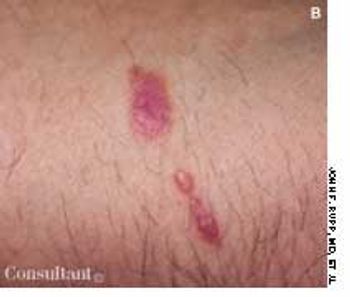
Lichen planus is characterized by flat-topped, polygonal, purple pruritic papules that have a predilection for flexor aspects of the wrists and forearms, sides of the neck, thighs, shins, and lower back. Lesions on the oral mucosa appear as white, lacy patches.
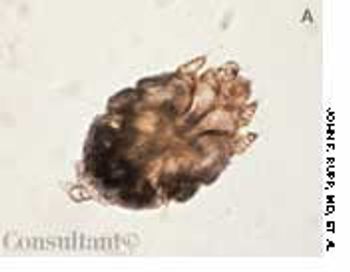
Persistent, unremitting itch-which intensifies at night-is the chief complaint of patients with scabies. The female Sarcoptes scabiei mite (A) burrows into the stratum corneum, where she lays eggs. The parasite is transferred by intimate contact and fomites, such as infested clothing, towels, and bedding.
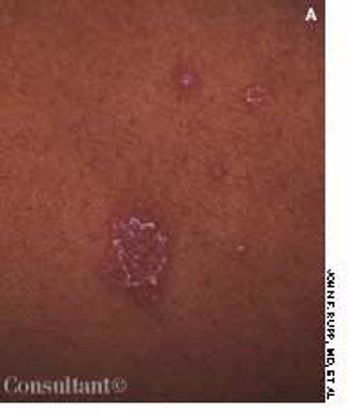
This self-limited eruption is characterized by erythematous, scaling, oval-shaped macules on the trunk and proximal extremities. Most outbreaks begin with a single, large patch-a mother or herald patch-that typically is found on the trunk. Commonly, this lesion is confused with ringworm.
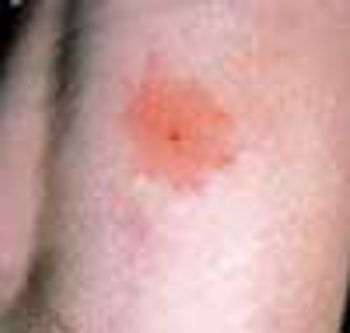
Acute allergic reactions from the bites of the common dog tick, Dermacentor variabilis, resemble reactions from bites of mosquitoes and other insects. Following removal of the tick from the patient's back, this inflamed, pruritic plaque developed at the site. Once all parts of the tick are removed, these bites generally respond to topical corticosteroids.
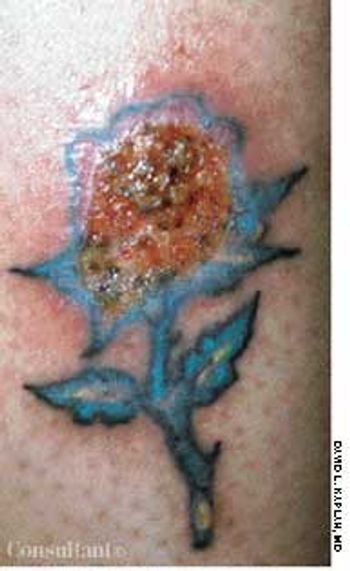
A 32-year-old woman with insulin-dependent diabetes noted a painful erosion at the site of "the rose tattoo," which she had gotten 5 days before.

A 5-year-old girl is brought for evaluation of an asymptomatic inflamed streak on one leg that has been present for several weeks. She is otherwise healthy and takes no medications.

A 45-year-old woman presents for evaluation of increased pigmentation on the sides of her neck. The discoloration has been present for at least several months and is asymptomatic.

A slowly progressive rash; pruritic lesions in the antecubital fossae; circular scaling, erythematous plaques--can you identify the disorders pictured here?

Is this acneform eruption on a middle-aged woman’s face perioraldermatitis? Rosacea? Pyoderma faciale? Is this pruritic rash related to ayoung woman’s tanning salon visits? Scrutinize the photos, make yourdecisions, and compare your answers with an expert’s.

A 39-year-old woman has a tender vesicular rash on her finger. A similar rash that had appeared on the same finger 1 year earlier responded slowly to a course of oral cephalexin

This crusted eroded area on the lower lip of a 67-year-old man has been presentfor several months.Which of the following statements are true?A. This condition preferentially affects the lower lip.B. It is more common in women.C. It is more common in immunocompromised patients.D. It is more likely to metastasize than similar lesions on nonmucosal surfaces.E. 5-Fluorouracil is contraindicated in this location.

For several months, a 49-year-old woman has had asymptomatic loss of pigmenton her shins. She has no history of injury to the area.What is your clinical impression?

Painful erosions developed on the sole of a 14-year-old girl's foot several weeksearlier. Within the last few days, the condition has spread to the other sole.The patient is otherwise healthy and takes no medications. She enjoys playingsoccer and has no history of trauma.